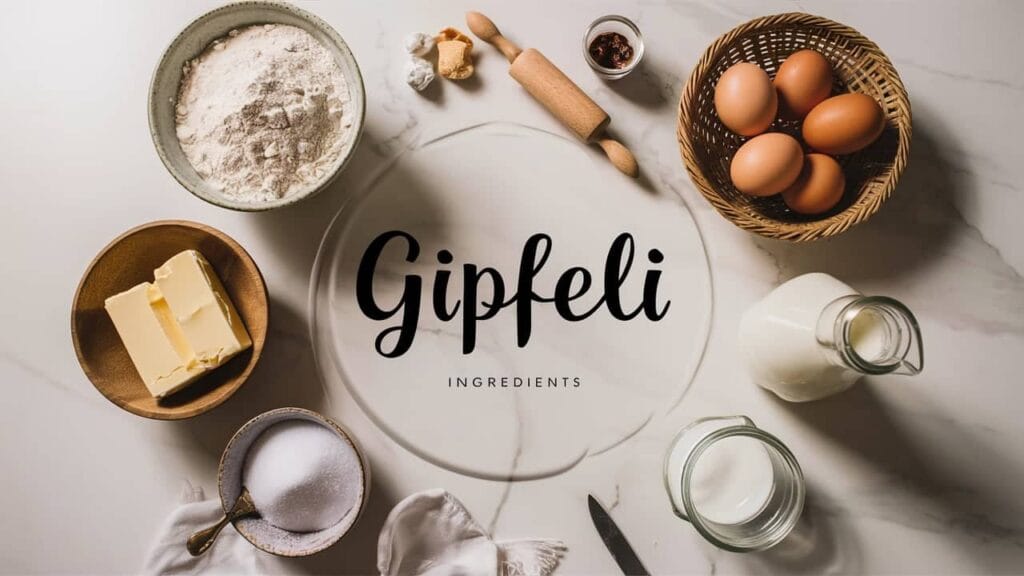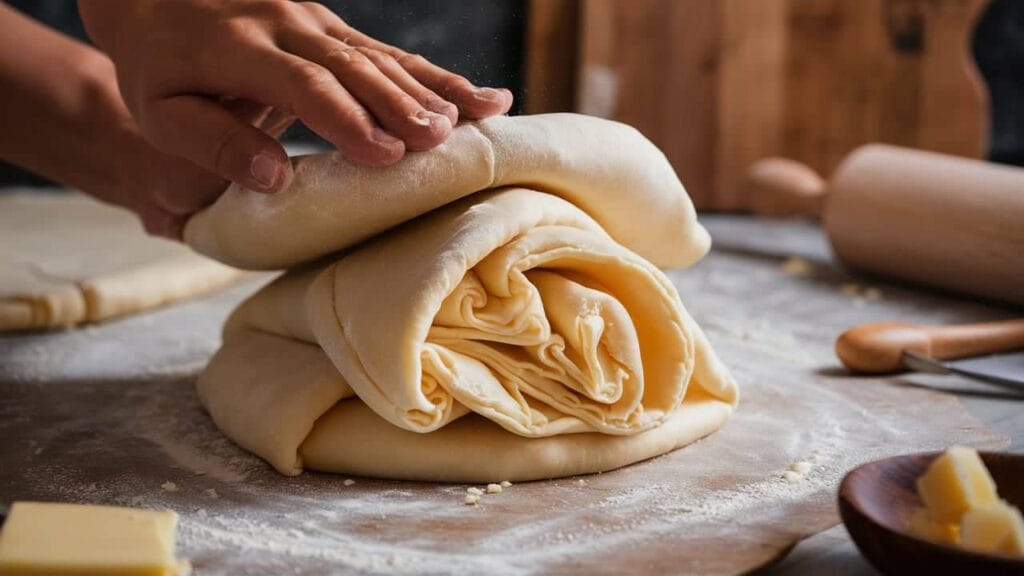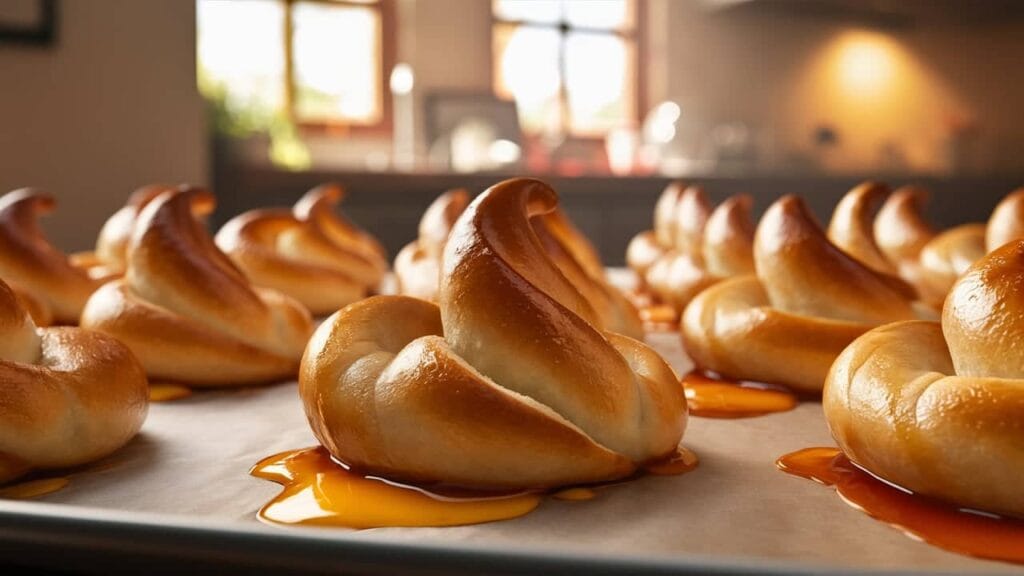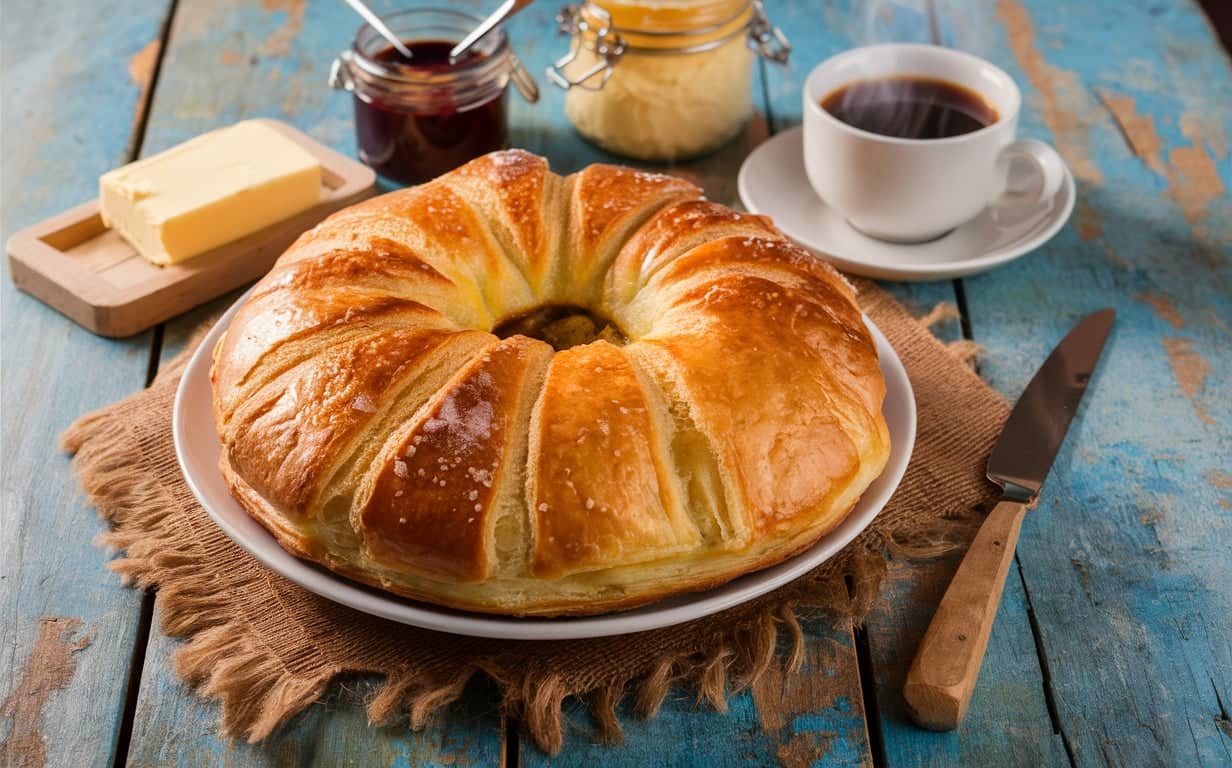Are you ready to bake something magical? Imagine biting into a flaky, buttery pastry that practically melts in your mouth. That’s Gipfeli Recipe! Whether you’re a seasoned baker or just starting out, this guide will walk you through everything you need to know to make perfect Gipfeli right in your own kitchen. Let’s roll!
Table of contents
What Is Gipfeli Recipe?
The Origins of Swiss Gipfeli Recipe
Gipfeli Recipe is Switzerland’s answer to the croissant—but with its own unique twist. While the French croissant is all about lightness and layers, Gipfeli is a bit denser, slightly sweeter, and perfect for breakfast or a midday snack. It’s been a staple in Swiss bakeries for decades, loved by locals and tourists alike.
Fun fact? The word “Gipfeli” comes from the German word “Gipfel,” which means “peak” or “summit” because of its crescent-like shape.
Why Gipfeli Recipe Is Different from Croissants
You might wonder, “Isn’t Gipfeli Recipe just a croissant?” Not quite! Unlike croissants, Gipfeli Recipe uses less butter during the lamination process, resulting in a texture that’s somewhere between a pastry and bread. Plus, Gipfeli often has a touch of sugar in the dough, giving it a subtly sweet flavor.
If croissants are a Parisian romance, Gipfeli Recipe is like a cozy Swiss chalet—warm, inviting, and oh-so-comforting.
Ingredients for Perfect Gipfeli Recipe
Essential Ingredients Breakdown
Great Gipfeli Recipe starts with simple, high-quality ingredients. Here’s what you’ll need:

- Flour: Use all-purpose flour for the best texture.
- Butter: Unsalted and chilled butter is key for those delicate layers.
- Milk: Full-fat milk makes the dough rich and flavorful.
- Yeast: Active dry yeast helps the dough rise beautifully.
- Sugar: Adds just the right touch of sweetness.
- Salt: Balances the flavors.
- Eggs: For enriching the dough and brushing the pastry before baking.
Substitutes for Hard-to-Find Items
No Swiss butter? No problem! European-style butter or any high-fat butter will work wonders. If you’re out of full-fat milk, a mix of half-and-half or even plant-based milk can substitute in a pinch.
Tools You’ll Need to Bake Gipfeli Recipe
Must-Have Kitchen Tools
Before diving in, gather these essentials:
- Rolling Pin: For laminating the dough.
- Pastry Brush: To apply egg wash for that golden sheen.
- Baking Sheet: A sturdy tray ensures even baking.
- Mixing Bowls: Various sizes for prepping ingredients.
Optional Gadgets for Better Results
If you’re looking to take your Gipfeli Recipe game to the next level, consider these:
- Dough Scraper: Makes handling dough easier.
- Kitchen Scale: Precision is everything when it comes to pastries.
- Pastry Cutter: For shaping the dough into perfect crescents.
“The secret to perfect Gipfeli lies in patience and precision. Don’t rush the dough—it’s like a fine wine; it needs time to develop!”
Step-by-Step Process for Making Gipfeli Recipe
Ready to roll up your sleeves and make some magic? Here’s the ultimate step-by-step guide to baking the most delicious Gipfeli ever.
Preparing the Dough
Making the perfect Gipfeli dough is where the journey begins. Here’s how:
- Activate the Yeast:
- Warm up 1/2 cup of milk (not too hot, just lukewarm like a cozy bath).
- Add 1 teaspoon of sugar and 1 packet of active dry yeast. Let it sit for 5-10 minutes until it’s frothy.
- Mix the Dry Ingredients:
- In a large bowl, combine 3 cups of all-purpose flour, 2 tablespoons of sugar, and a pinch of salt.
- Combine Wet and Dry:
- Make a well in the center of the flour mixture, then pour in the yeast mixture and 2 beaten eggs. Stir until a shaggy dough forms.
- Add Butter:
- Knead in 2 tablespoons of softened butter. This makes the dough rich and elastic.
- Knead and Rest:
- Knead the dough on a floured surface for about 10 minutes until it’s smooth.
- Cover with a damp cloth and let it rise for 1-2 hours, or until doubled in size.
Laminating the Butter
Laminating might sound fancy, but it’s just layering butter into dough for that flaky texture. Let’s break it down:
Butter layers being folded into Gipfeli dough for flakiness.

- Chill the Butter Block:
- Take 1 cup of chilled butter and shape it into a flat rectangle, about 6×8 inches. Wrap it in parchment paper and refrigerate it until firm.
- Roll Out the Dough:
- Roll the rested dough into a rectangle slightly larger than your butter block.
- Enclose the Butter:
- Place the butter block in the center of the dough. Fold the dough edges over it like a letter.
- Roll and Fold:
- Roll the dough out into a long rectangle, then fold it into thirds. This is called a “turn.”
- Chill the dough for 30 minutes, then repeat the rolling and folding process 2 more times. This creates layers—like magic, but tastier!
Shaping and Proofing
Now that your dough is laminated, it’s time to shape those iconic crescent rolls.

- Cut the Dough:
- Roll out the dough into a large rectangle, about 1/4 inch thick. Cut it into triangles, each about 4 inches wide at the base.
- Shape the Gipfeli:
- Take each triangle and roll it tightly from the wide base to the tip, forming a crescent shape. Curve the edges slightly for that classic look.
- Proof the Shaped Dough:
- Place the Gipfeli on a baking sheet lined with parchment paper. Cover lightly with plastic wrap and let them proof for 30-45 minutes until puffy.
Baking to Golden Perfection
Finally, it’s time to bake your Gipfeli to golden, flaky perfection.
- Preheat the Oven:
- Set your oven to 375°F (190°C).
- Apply Egg Wash:
- Whisk 1 egg with a splash of milk and gently brush it over the Gipfeli. This gives them that irresistible golden glow.
- Bake:
- Bake for 15-20 minutes, or until the Gipfeli are puffed and golden brown.
- Cool and Enjoy:
- Let them cool slightly before digging in. Serve warm for the ultimate experience.
“Making Gipfeli is like building a house—every layer adds strength and beauty. Take your time, and the results will be worth it!”
Pro Tip: Don’t Skip the Chill
When laminating the dough, chilling between folds is critical. It helps the butter stay firm, which creates those dreamy layers. Think of it as giving your dough a nap—rested dough is happy dough!
Common Problems & How to Solve Them
No one gets it perfect the first time, and that’s okay! Making Gipfeli is an art, and even the best bakers face challenges. Let’s troubleshoot the most common issues so you can bake with confidence.
Why Isn’t My Gipfeli Recipe Flaky Enough?
Lack of flakiness can be disappointing, but don’t worry—it’s usually a simple fix.
- Problem: The butter melted into the dough during lamination.
- Solution: Always chill the dough between folds. If your kitchen is warm, pop the dough in the fridge for 10-15 minutes during rolling. Keep your butter firm but pliable.
- Problem: Not enough folds during lamination.
- Solution: Aim for at least 3-4 folds to create those signature layers. It’s like stacking paper—you need enough sheets to see the layers!
Troubleshooting Dough Issues
Sometimes, the dough just doesn’t behave the way you want. Let’s fix that.
- Problem: The dough is too sticky to handle.
- Solution: Dust your work surface and rolling pin with flour, but don’t overdo it! Too much flour can make the dough dry.
- Problem: The dough didn’t rise properly.
- Solution: Check your yeast. If it doesn’t foam during activation, it’s probably expired. Also, ensure your milk isn’t too hot—it should feel warm, not scorching.
How to Fix Overbaking
Overbaked Gipfeli can turn into sad, dry pastries. Let’s avoid that!
- Problem: The Gipfeli are too dark or crispy.
- Solution: Keep an eye on the oven in the last 5 minutes of baking. If they’re browning too quickly, tent them with foil.
- Problem: Dry or tough texture.
- Solution: Avoid overproofing the dough—it should be puffy but not doubled in size during the final proof.
“Baking is a science, but it’s also forgiving. When something goes wrong, think of it as a lesson for your next bake!”
Pro Tips for Consistent Results
- Room Temperature Matters: If your butter or dough is too warm, things can get messy fast. Keep everything cool!
- Use a Timer: Don’t guess—set timers for folding, proofing, and baking. Precision is your best friend.
- Practice Makes Perfect: Your first batch might not be bakery-perfect, and that’s okay! Each attempt will get better.
Don’t Forget About the Oven!
- Use an oven thermometer to ensure your temperature is accurate. Even a small difference can impact your Gipfeli.
- Bake on the middle rack for even heat distribution.
Serving and Storing Gipfeli Recipe
Your kitchen now smells like a Swiss bakery, and your freshly baked Gipfeli are begging to be enjoyed. But how do you serve them, and what’s the best way to store any leftovers? Let’s dive in!

Best Ways to Serve Gipfeli Recipe
Gipfeli Recipe isn’t just a pastry—it’s an experience! Here are some ideas to elevate your serving game:
- Traditional Swiss Breakfast:
Serve Gipfeli Recipe with butter, jam, or honey alongside a steaming cup of coffee or hot chocolate. It’s the classic Swiss way! - Savory Twist:
Fill your Gipfeli Recipe with ham and cheese before baking for a hearty breakfast or lunch option. Think of it as the Swiss version of a sandwich! - Fancy Presentation:
Dust your pastries with powdered sugar or drizzle with a light glaze for an extra touch of sweetness. Pair them with fresh fruit for a stunning brunch spread.
“Pairing Gipfeli Recipe with homemade jam takes it from delicious to unforgettable. It’s the perfect balance of sweet and buttery!”
Storing Tips for Freshness
You’ve worked hard to make these delightful pastries, so let’s make sure they stay fresh.
- Short-Term Storage:
Place leftover Gipfeli Recipe in an airtight container at room temperature. They’ll stay fresh for up to 2 days. To enjoy them warm, pop them in the oven at 350°F (175°C) for 5 minutes. - Long-Term Storage:
Freeze your Gipfeli! Wrap each pastry in plastic wrap, then store them in a freezer-safe bag. When you’re ready to enjoy, thaw them at room temperature and reheat in the oven for that just-baked taste.
Tips for Beginners
If you’re new to baking Gipfeli, don’t worry—I’ve got your back! Here are some quick tips to help you succeed:
Mistakes to Avoid
- Skipping the Chill: This is the number one mistake. Warm dough equals flat, greasy Gipfeli Recipe. Keep it cool!
- Rushing the Process: Good Gipfeli Recipe takes time. Be patient, and you’ll be rewarded with buttery layers.
Quick Hacks for Better Results
- Use Pre-Chilled Butter Sheets: If laminating feels intimidating, pre-made butter sheets can save time and effort.
- Work in Batches: If you’re nervous about handling a large dough, divide it into smaller portions to make it more manageable.
Frequently Asked Questions (FAQ)
Q: Can I freeze Gipfeli Recipe dough?
Absolutely! After shaping the Gipfeli Recipe, place them on a baking tray and freeze until solid. Transfer to a freezer bag, and they’ll keep for up to 3 months. When ready to bake, thaw overnight in the fridge and proof before baking.
Q: How long does it take to make Gipfeli Recipe?
From start to finish, it typically takes about 6-8 hours, including resting and proofing time. While it’s not a quick process, the results are worth every minute.
Q: Can I make Gipfeli Recipe without yeast?
While traditional Gipfeli Recipe relies on yeast for its signature texture, you can experiment with puff pastry if you’re short on time. It won’t be the same, but it’ll still be delicious!
“The joy of baking Gipfeli isn’t just in eating them—it’s in the process. Each step is a little act of love that pays off with every buttery bite!”

